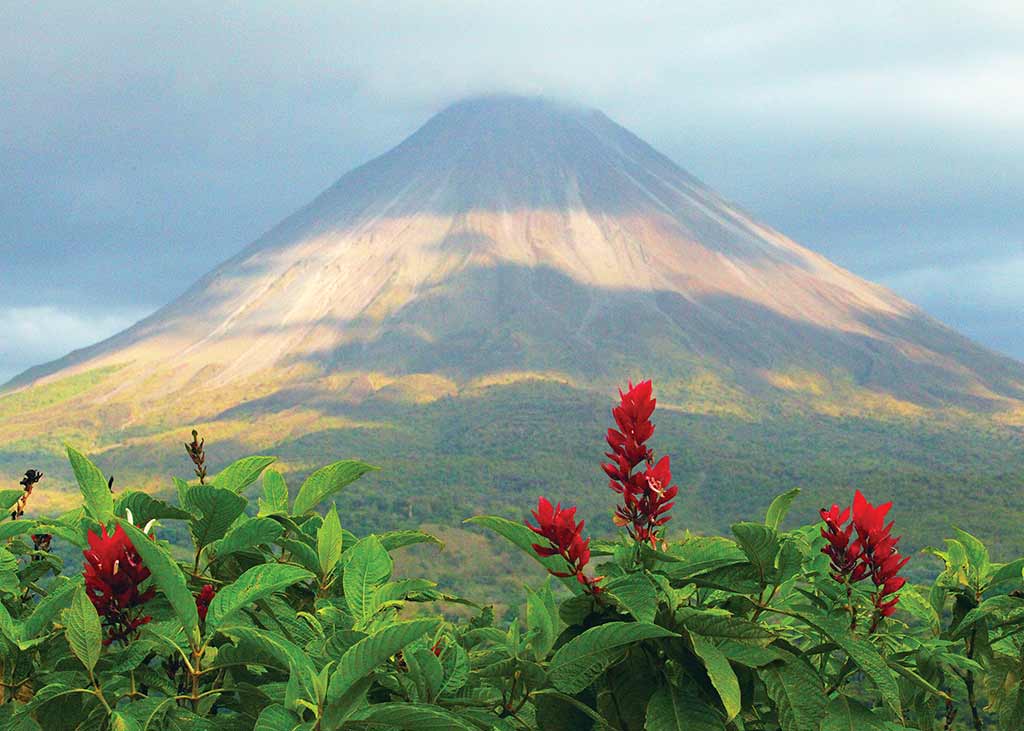To relax, unwind, and adventure, Costa Rica truly offers something for everyone. Each region has its own speciality of sorts, such as the thriving nightlife of San José, the crisp, cool cloud forests of Monteverde, or the white-sand beaches of the Nicoya Peninsula, and while it’s not terribly difficult to get around, planning ahead of time where you’d like to spend your time–always with a little flexibility–makes for truly memorable travels.
Here’s where to go in Costa Rica.

Arenal Volcano stands tall in the Northern Zone of Costa Rica. Photo © Christopher P. Baker.
The bustling capital city is a handy hub for forays farther afield. Pre-Columbian artifacts are exhibited at three small yet excellent museums; a handful of galleries satisfy art enthusiasts; and souvenir shoppers are well served by quality crafts stores. The city boasts superb restaurants, thriving nightlife, and great hotels.
This humid zone is notable for its Afro-Caribbean culture. Offbeat Cahuita and Puerto Viejo draw surfers and backpackers and serve as departure points for treks into indigenous reserves. Wildlife-rich Parque Nacional Cahuita and Parque Nacional Tortuguero are easily accessed—the latter by canal from waterfront nature lodges. Marine turtles lay eggs up and down the coast. Anglers are gung-ho about Barra del Colorado.
The northern lowland is a center for active adventures focused around Parque Nacional Volcán Arenal. Hiking, hot springs, horseback riding, and zip-line adventures are popular. Laguna de Arenal draws windsurfers and freshwater anglers, while the Caño Negro wildlife refuge is a nirvana for bird-watchers. Nature lodges grant access to rugged Parque Nacional Braulio Carrillo, and the Volcán Tenorio region is evolving as a new frontier for active adventures.
The northwest is distinct for its dry climate and deciduous tropical forests: Bird-watching is superb at Parque Nacional Palo Verde and Parque Nacional Santa Rosa, which boasts historical sites. This is also cowboy country; numerous ranches double as eco-oriented activity centers at the base of volcanoes. A big draw is Monteverde, a mountain idyll boasting attractions and activities that will hold your attention for days.
This region is known for its white-sand beaches linked by an unpaved coastal road that may require fording rivers. Scuba diving, surfing, and sportfishing are key draws. Playa Grande and Ostional are important nesting sites for marine turtles. Inland, Guaitíl preserves its indigenous pottery tradition, and nearby Barra Honda is the nation’s major speleological site. Accommodations range from surf camps to sublime high-end resorts, concentrated at Playa Tamarindo and Bahía Culebra.
Forest-clad mountains hem a narrow coastal plain fringed by beaches. Jacó, Costa Rica’s most developed resort, is popular with the party crowd. Tárcoles is great for crocodile safaris; Parque Nacional Carara offers world-class bird-watching; and Manuel Antonio combines wildlife encounters with a huge selection of fine lodging and dining. Nearby Quepos is a center for sportfishing. Whale-watching draws visitors to the Costa Ballena.
Soaking rains nurture the forests of Parque Nacional Corcovado. The humble port of Golfito is a base for sportfishing and forays to remote rainforest lodges. Kilometer-long waves wash up at surf capital Pavones. Tucked-away Drake Bay is good for diving and whale-watching excursions and trips to Isla del Caño, an erstwhile indigenous ceremonial site. Some 500 kilometers (300 miles) southwest of mainland Costa Rica, Isla del Coco is off-limits to all but experienced divers.
The nation’s Cinderella region draws birders and nature lovers to Los Cusingos and Wilson Botanical Garden. Hale and hearty adventure seekers follow the trail up Chirripó, the nation’s highest mountain; the trailhead is accessed by one of several Shangri-la valleys that lead into the rugged Parque Internacional La Amistad. Indigenous communities exist in isolation, but the easy-to-reach village of Boruca offers an initiation.
Excerpted from the Tenth Edition of Moon Costa Rica.